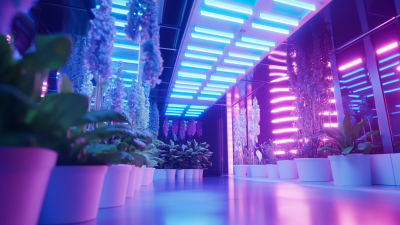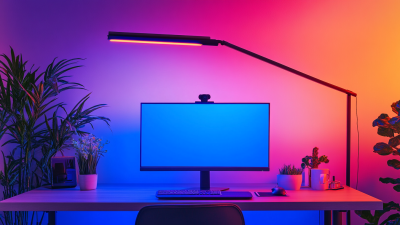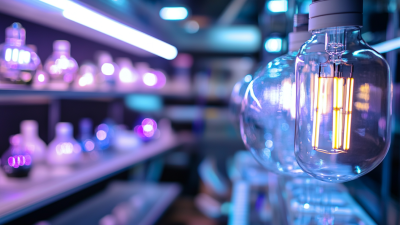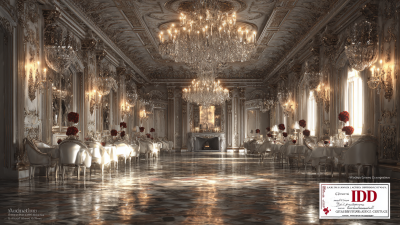7 Best Benefits of Using Led Lamps for Your Home and Business
In today’s fast-paced world, the demand for efficient and sustainable lighting solutions has never been more critical. According to the U.S. Department of Energy, LED lamps are projected to account for 84% of the total incandescent light bulb market by 2025, demonstrating their significant impact on both home and business environments. LED lamps not only offer exceptional energy efficiency, consuming up to 75% less energy than traditional incandescent bulbs, but they also boast a longer lifespan, lasting up to 25 times longer. This shift towards LED technology not only reduces energy costs but also contributes to a smaller carbon footprint, aligning with global sustainability initiatives. As more consumers and businesses recognize these advantages, understanding the multifaceted benefits of LED lamps becomes essential for making informed decisions that enhance both operational efficiency and environmental responsibility.

Advantages of Energy Efficiency: Why LED Lamps Save You Money
When considering energy efficiency in your home and business, LED lamps stand out as a top choice due to their remarkable ability to save money over time. Traditional incandescent bulbs can lead to over $100 in wasted energy annually, making the switch to LED not only smart but necessary. By utilizing significantly less energy for the same light output, LED bulbs can cut energy costs by up to $75 per year for the average consumer. This significant savings is a result of their enhanced efficiency, which has been proven to be up to 44% greater than that of standard fluorescent tubes.
Moreover, LEDs offer a sustainable solution for those looking to expand their use of lighting without incurring exorbitant costs. For instance, festive lighting displays, like the classic Griswold-style Christmas light setup, could potentially result in hundreds of dollars in electric bills if one isn't cautious. However, implementing LED lighting can mitigate these expenses, ensuring that your home or business shines bright during the holidays without breaking the bank. By embracing LED technology, you’re not only making a cost-effective choice but also a responsible one that contributes to a greener planet.

Enhancing Aesthetic Appeal: How LED Lighting Transforms Your Space
LED lighting not only offers energy efficiency and cost savings but also significantly enhances the aesthetic appeal of any space. According to a report by the U.S. Department of Energy, LED lighting uses up to 75% less energy than traditional incandescent bulbs, allowing for innovative applications in home and business design without the burden of high energy costs. This energy efficiency translates into more creative lighting designs that can highlight architectural features and create inviting atmospheres.
Furthermore, a study from the National Lighting Bureau shows that well-designed lighting can improve mood and productivity, making LED solutions ideal for both residential and commercial environments. The versatility of LED lamps allows for a range of color temperatures and styles, enabling designers to craft unique ambiances. Whether it's the warm, inviting glow of soft white LEDs in living spaces or the bright, focused light in retail environments, LED lighting can transform a mundane area into a remarkable showcase, enhancing visual interest while providing superior illumination. This transformation not only elevates the overall aesthetic quality but also influences how people perceive and interact with the space around them.
7 Best Benefits of Using LED Lamps for Your Home and Business - Enhancing Aesthetic Appeal: How LED Lighting Transforms Your Space
| Benefit | Description | Impact on Aesthetics |
|---|---|---|
| Energy Efficiency | LED lamps consume significantly less electricity than traditional bulbs, reducing energy costs. | Lower energy consumption allows for a more sustainable aesthetic environment. |
| Longevity | LED lights have a lifespan of up to 25,000 hours or more, minimizing the need for frequent replacements. | Fewer replacements mean consistent lighting quality, enhancing the overall look of the space. |
| Variety of Colors | LEDs provide a wide range of color temperatures and vibrant colors for creative lighting choices. | Different colors can greatly affect the mood and aesthetic of any room. |
| Low Heat Emission | LEDs emit very little heat compared to incandescent bulbs, making spaces more comfortable. | Lower heat levels contribute to a cool and refreshing environment. |
| Durability | LEDs are solid-state lights, making them more resistant to breakage and damage. | Robust lighting solutions enhance the aesthetic longevity of décor. |
| Smart Lighting Options | Many LEDs can be integrated with smart home systems for personalized lighting control. | Smart controls help create dynamic lighting experiences that enhance aesthetics. |
| Environmentally Friendly | LEDs contain no toxic materials and are 100% recyclable. | Choosing eco-friendly lighting options contributes positively to space aesthetics. |
Longevity and Durability: The Lasting Benefits of LED Technology
The longevity and durability of LED lamps are two of the most compelling reasons to switch to this lighting technology for homes and businesses.
Unlike traditional incandescent bulbs that typically last around 1,000 hours, LED lamps boast a remarkable lifespan of up to 25,000 to 50,000 hours, according to the U.S. Department of Energy. This astounding difference means that when you invest in LED lighting, you significantly reduce the frequency and cost of replacements, making it a smart choice economically and environmentally.
Additionally, the robust construction of LED lamps contributes to their durability. Unlike fragile incandescent and fluorescent bulbs, LEDs are designed to withstand shocks, vibrations, and extreme temperatures, making them ideal for both residential and commercial applications. A study by the Lighting Research Center at Rensselaer Polytechnic Institute suggests that even in harsh conditions, LED technology maintains its performance, thus reducing maintenance costs associated with changing lights in difficult-to-reach areas.
This resilience not only ensures a consistent and reliable lighting solution but also emphasizes the long-term benefits of adopting LED technology in any setting.
Environmental Impact: How LED Lamps Contribute to Sustainability
LED lamps are quickly becoming the preferred lighting choice for both homes and businesses, primarily due to their positive environmental impact. When compared to traditional incandescent bulbs, LED lights consume significantly less energy—up to 80% less—leading to a substantial reduction in greenhouse gas emissions. This shift not only lowers energy bills but also contributes to a smaller carbon footprint, making LED lighting a cornerstone of sustainable living.
In addition to energy efficiency, LED lamps have a longer lifespan, often lasting up to 25 times longer than conventional bulbs. This durability means fewer bulbs in landfills, which is crucial for reducing waste and conserving resources. When disposing of LED lights, it is important to recycle them appropriately to minimize environmental harm.
Tip: When upgrading to LED lamps, look for reputable brands that offer energy-efficient certified products. Not only will this ensure better performance, but it also supports companies committed to sustainable practices. Additionally, consider incorporating smart lighting solutions that allow for automated control, further enhancing energy conservation in your home or business.
Versatile Applications: Ways to Use LED Lighting in Both Home and Business
 LED lighting has transformed the way we illuminate both homes and businesses, offering unmatched versatility in applications. According to the U.S. Department of Energy, LED lighting can use up to 75% less energy than traditional incandescent bulbs, making it an attractive option not only for reducing utility bills but also for contributing to environmental sustainability. In a residential setting, LEDs can be used for everything from recessed lighting to accent lights, enhancing aesthetic appeal while providing excellent illumination. For businesses, LED strip lights can highlight products in retail spaces, while smart LED fixtures in offices can create an adaptable workspace environment, increasing productivity and employee satisfaction.
LED lighting has transformed the way we illuminate both homes and businesses, offering unmatched versatility in applications. According to the U.S. Department of Energy, LED lighting can use up to 75% less energy than traditional incandescent bulbs, making it an attractive option not only for reducing utility bills but also for contributing to environmental sustainability. In a residential setting, LEDs can be used for everything from recessed lighting to accent lights, enhancing aesthetic appeal while providing excellent illumination. For businesses, LED strip lights can highlight products in retail spaces, while smart LED fixtures in offices can create an adaptable workspace environment, increasing productivity and employee satisfaction.
Furthermore, advancements in LED technology have paved the way for innovative applications. For instance, LEDs are now available in smart lighting systems that can be controlled remotely via smartphone apps, enabling homeowners and business owners to optimize lighting according to their needs. A report by Research and Markets predicts the global smart LED market will grow significantly, with widespread adoption in smart homes and commercial environments. This trend underscores how LED lighting not only meets functional needs but also aligns with the growing emphasis on energy efficiency and smart technology integration in our daily lives.
Related Posts
-

Ultimate Checklist for Choosing the Right LED Lamps for Your Space
-

The Evolution of Led Fixture Light Technology for a Sustainable Tomorrow
-

Exploring the Essential Technical Specifications of Cutting Edge LED Lamps
-

Exploring the Technical Specifications of Best Led Lamps and How to Choose the Right One
-

How to Choose the Best Led Lighting for Cost Efficiency and Sustainability in Global Markets
-

Achieving Best Lighting Decoration with Industry Import Export Certification Guidelines
